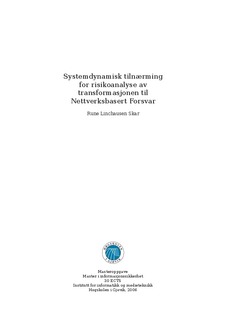| dc.contributor.author | Skar, Rune Linchausen | |
| dc.date.accessioned | 2008-03-28T07:46:11Z | |
| dc.date.issued | 2006 | |
| dc.identifier.uri | http://hdl.handle.net/11250/143859 | |
| dc.description.abstract | NORSK:
Overgangen til et nettverksbasert konsept for krigføring vil medføre en omfattende transformasjon
av Forsvaret. Konseptets kjerne ligger i å skape en radikal prosessforbedring
gjennom innovativ bruk av informasjons- og kommunikasjonsteknologi. Målet med transformasjonen
er å oppnå en radikal forbedring av Forsvarets evne til å skape militær
effekt. Den vil medføre omfattende forandring av virksomhetsprosesser, rutiner og hvordan
man utfører militære operasjoner. Konseptet muliggjøres gjennom utviklingen av
en datamaskinbasert informasjonsinfrastruktur som skal knytte sammen tilnærmet alle
enhetene i fremtidens Forsvar. Forsvarets evne til å skape militær effekt vil derfor være
svært avhengig av en sikker funksjon for denne informasjonsinfrastrukturen.
Vi har i denne undersøkelsen utviklet en kvalitativ systemdynamisk modell som viser
hvordan utilsiktet effekt relatert til risikobildet for informasjonsinfrastrukturen oppstår
som et resultat av nettverksorganiseringen. Innsikten i de dynamiske kreftene som virker
i systemet og hvordan utilsiktet effekt kan minimaliseres er kommunisert gjennom en
problemarketype og en løsningsarketype. Innsikten viser at risikobildet for informasjonsinfrastrukturen
endres dynamisk med grad av nettverksorganisering i Forsvaret. Dersom
dette forholdet ikke hånderes på en adekvat måte, har det potensiale til å redusere eller
i verste fall annullere forventet effekt av nettverksorganiseringen.
Siden Forsvaret i all hovedsak bare kan påvirke risikobildet gjennom en reduksjon av
sårbarheter og virkningen av logiske angrep mot informasjonsinfrastrukturen, foreslås
følgende policy for Forsvarets transformasjon til Nettverksbasert forsvar: For å sikre realisering av effektpotensialet i Nettverksbasert forsvar, skal økt bruk
av ressurser for nettverksorganisering av Forsvaret medføre parallelt økt bruk av
ressurser for håndtering av risiko for logiske angrep mot informasjonsinfrastrukturen.
Bruken av ressurser skal baseres på en intelligent og kosteffektiv kombinasjon
av forebyggende, detekterende og reagerende tiltak. | no |
| dc.description.abstract | ENGELSK:
The transition towards a network centric concept for warfare will cause a comprehensive
transformation for the Norwegian Defence. In the core of the concept we find the
need to create a radical improvement of the processes through innovative use of information
and communication technologies. The purpose of this transformation is to achieve
a radical improvement in the Norwegian Defences ability to create military effect. It will
bring about an extensive change in operational processes, routines and how we conduct
military operations. The concept is enabled through the developement and implementation
of a computer-based information infrastruture that will connect virtually all units
in the Norwegian Defence of the future. The Norwegian Defences ability to create military
effect will therefore be very much dependent of a functional and secure information
infrastructure.
In this master thesis we have developed a qualitative model based on system dynamics,
that point out how unintended effects that affect the risk level in the information
infrastructure manifest itself as a result of the network centric organisation. Knowledge
of the dynamic forces that work in this system, and how unintended effect can be minimized
is communicated through a problem archetype and a solution archetype. This
insight demonstrates that the risk picture for the information infrastructure changes according
to the degree of network centric organisation in the Norwegian Defence. If this
condition is not handled adequately, it has the potential to reduce or, in the worst case,
nullify the anticipated effect of network centric organisation.
The Norwegian Defence can influence the risk picture mainly by reducing the number
of vulnerabilities and the impact of logical attacks on the information infrastructure.
We therefore propose the following policy for the Norwegian Defences transformation
towards a network centric organisation:
To ensure the realization of the effect-potential in a network centric defence,
increased use of resources in network centric organisation shall be followed by
a parallell increased use of resources in handling the risk of logical attacks on the
information infrastructure. The use of resources shall be based on an intelligent
and cost-effective combination of prevention, detection and reaction measures. | en |
| dc.format.extent | 3508897 bytes | |
| dc.format.mimetype | application/pdf | |
| dc.language.iso | eng | en |
| dc.subject | informasjonsteknologi | en |
| dc.subject | kommunikasjonsteknologi | en |
| dc.subject | infrastruktur | en |
| dc.subject | nettverk | en |
| dc.title | Systemdynamisk tilnærming for risikoanalyse av transformasjonen til Nettverksbasert Forsvar | en |
| dc.type | Master thesis | en |
| dc.subject.nsi | VDP::Mathematics and natural science: 400::Information and communication science: 420::Security and vulnerability: 424 | en |
